Mrs. Emma Exley, – later Mrs Emma Stubbins (nee Emma Willson)
1824 – 1889
( insert photo)
Photographic Business
Mrs. Emma Exley was born Emma Willson but her photographic career was in her married name.
Emma was one of the first women to have a photographic studio in England and appears according to The Barnsley Times to have been running her first studio in Barnsley as early as 1855 and it is presumed that the business existed after her husband’s death in 1862 and up until her second marriage in 1869.
In 1869 she married again to a Thomas Stubbings (aka Stubbins) and operated a studio with him in Worksop in the name of Exley & Stubbins. The 1871 census shows Emma as a photographer and her husband as a wheelwright. It is assumed that Emma ran the photography business under the name of Exley & Stubbins.
Her son Thomas Exley, from her first marriage, was also listed in 1871 as a photographer living in Worksop.
By 1881 Thomas Stubbins was listed as a farmer and Emma as a farmer’s wife.
Emma died in 1889.
Census
1841 – age 15, at the household of Timothy’s father, Thomas, in Barnsley. Timothy was a weaver and Emma , at 15, did not have an occupation recorded.
1851 – age 28, at Malton Place, Barnsley with Timothy Exley (a debt collector) and their 3 living children Mary Ann, Thomas and Susan. Emma’s occupation was not recorded.
1861 – census record not found
1871 – age 45, now Mrs Emma Stubbins (photographer), at Elmton near Cresswell with husband Thomas Stubbins (wheelwright) and six children and three lodgers (a painter and two joiners)
1871 – age 24, Thomas Exley (photographer), single, at 8 New Road Worksop
1881 – age 55, Mrs. Emma Stubbins (farmer’s wife) at Lound Common with Thomas Stubbins, Mary Ann Exley, Agnes Exley and a servant.
Mrs. Emma Exley was born Emma Willson in 1824.
She married her first husband, Timothy Exley in Worsbrough, near Barnsley, West Riding of Yorkshire on the 28th January 1841 when she was only 16 years old. Timothy and Emma went on to have ten children; seven girls and three boys.
In 1841, the couple lived in the household of Timothy’s father, Thomas Exley, in Barnsley with Timothy’s four brothers. Timothy’s father and the four eldest boys were all weavers.
Children soon arrived but not all of their children survived into adulthood. Their eldest child Jane Ann Exley may have died in the Autumn of 1846 at the age of three followed by their third daughter, Emma, in the spring of 1849 when she was only a few months old. The General Register Office Index (G.R.O.) cites the death of a Jane Exley and Emma Exley in these years.
By 1851, Emma and Timothy had their own home in Malton Place, Barnsley and Timothy was working as a debt collector. Emma’s occupation was not recorded. The children in their household were Mary Ann Exley aged six, Thomas Exley aged four and Susan Exley aged one. Mary Anne was still alive, however she may have died before 1854 as a second Mary Ann Exley was christened in 1854.
The first reference found so far with regard to Timothy Exley’s (rather than Emma’s) photographic studio comes in ‘Burland’s Annals’ held in the Barnsley Archive. These Annals are a collection of accounts describing events in Barnsley and District in the years 1744 -1864. Burland, by collecting items of information about the inhabitants of Barnsley, built up an interesting picture of the town. In the Annals he made reference to a monetary collection being made to help Timothy Exley financially recover from a fire which had completely destroyed the photographic studio along with its equipment. The first account is in 29th December 1855 edition of ‘The Barnsley Times’, which describes the following incident
|
THE BARNSLEY TIMES 29th December 1855
FIRE – Early on Saturday morning last a fire broke out in a building used as a photographic gallery, situate in a garden near St. George’s Church. The fire was discovered by a workman of Messrs. Harvey and Co. but from the inflammatory state of the chemicals it contained, the whole was destroyed in a very short time, despite the efforts of those who endeavoured to save the property. The building has been but lately erected, and was the property of Mr. Timothy Exley, who has sustained a loss of nearly £80. A subscription is being got up, to aid him in its restoration, in which, we doubt not, the public will readily sympathise. |
A week later ‘The Barnsley Times’ included a further write up of the incident.
|
THE BARNSLEY TIMES 5th January 1856
THE CASE OF TIMOTHY EXLEY – The subscription named in last week’s impression towards the loss sustained by Timothy Exley, from the burning of his photographic establishment, is now in progress. As an individual suffering loss, he has some claim to public sympathy; perhaps also as a public servant that claim is increased. The hard-worked class of letter-carriers, and every officer connected with the post office while their duties have increased in a manifold degree, have shared no proportionate increase in salary. Even Christmas boxes and clerks’ fees – once an important consideration – have dwindled to a shadow; where not asked for, it is concluded they are not required, and with a few liberal exceptions, are rarely given. The present case therefore doubly commands itself for remembrance at this season of the year, especially to all who reap the benefit of cheap correspondence. |
This plea caused a stir of interest in the population of Barnsley and on 26th January 1856 a letter appeared in the newspaper. It refers to a postman in Worsbrough who happened to be Joseph Exley, Timothy Exley’s uncle. To see further notes on Joseph Exley at the end of this article, click here.
What happened to the monetary collection for Timothy Exley’s Photographic Studio remains a mystery.
Surprisingly, no evidence of the family has yet been found in the 1861 Barnsley census. This would be a year before Timothy’s death.
In 1861, Emma advertised her studio in Barnsley in trade directories and, in Whites 1862 Trade Directory, Timothy Exley is identified as a postman and Emma Exley as a photographic artist. Their home address is Bank Yard but Emma had a Photographic Studio in St. Mary’s Place and St Marys Gate.
Emma’s entrepreneurial endeavours provide a most fascinating and remarkable twist to this family saga. Emma, unable to write at her marriage in Worsbrough in 1841, was to become one of the first photographers in Barnsley. This remarkable achievement for a woman working very much in a man’s world and also in the very infancy of photography provides a dramatic development to her story.
Barnsley Archive holds an interesting booklet on early photography written by Brian Elliott B.Ed (Hons), M. Phil and called ‘Barnsley’s Photographic Pioneers’. In it there is a list of professional photographers from 1850-1940. It is here that Emma Exley can be identified as the third earliest photographer in the town. Many of the 39 photographers are listed with initials but, of all those given Christian names, Emma is the only female highlighted in the list that covers almost a century of photography. The pamphlet contains an interesting account of Barnsley’s Photographic Pioneers along with a brief description of the technology involved in the early procedures. To see this article, click here.
In his obituary, published in the Saturday 31st May 1862 edition of the Barnsley Chronicle, it stated that Timothy of Jackson’s Yard, Church Street, Barnsley was employed as a letter courier for nearly 13 years. Nationally these were the years that saw the growth of the Royal Mail when Rowland Hill introduced many historic postal reforms. With the establishment of the new Penny Post, rates were calculated by weight starting at the minimum rate of a penny. The Penny Post introduced prepaid postage resulting in the development of the first postage stamp, the Penny Black. By 1855 roadside post boxes and residential postal slots became the norm and on 29th November 1860 the Barnsley Letter Carriers first appeared in scarlet coats. Sadly we do not know whether Timothy wore one of these scarlet coats or not.
From his death certificate it is apparent that he had suffered from ‘Morb Cordis’ for several years and Hydrops for two months. According to an internet site entitled ‘Diseases and Medical. Terms for Genealogists, ‘Morb Cordis’ refers to heart disease.
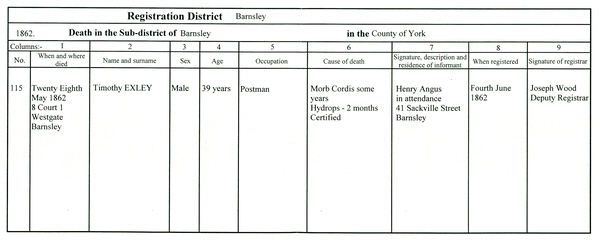
Timothy died at the age of 39 and left his widow with eight children ranging in age from Mary Ann of sixteen to Agnes of ten months.
For seven years after Timothy’s death we presume Emma remained in Barnsley and carried on running her photographic studio as well as caring for her children. However, on the 14th March 1869, Emma re-married. This time to Thomas Stubbin(g)s, a wheelwright from Worksop and following the marriage she moved to Elmton, a small village near Cresswell on the Nottinghamshire/Derbyshire border. It is interesting to note that in certain documents Stubbings includes a ‘g’ and in others the ‘g’ is missed out.
As we can see from the marriage certificate Emma, by this time, could write; though with a somewhat unsteady hand. Her daughter and soon to be son-in-law were the witnesses to this marriage that took place not at St. George’s Church, where Timothy Exley’s father was sexton and parish clerk but at the Parish Church of St. Mary’s.
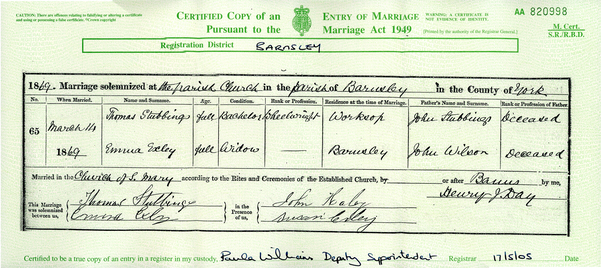
Thomas Stubbings, Emma’s new husband, baptized 6th March 1831 at Whitwell in Derbyshire, was the son of John Stubbings and Elizabeth Stubbings.
Thomas had a brother Henry Stubbings who was christened on 5th January 1823 and was to marry Christiana and in later life, at the time of 1881 census, Henry and Christiana were living at The Cross in Carlton in Lindrick close by Emma’s son, John William Exley. Thomas had a second brother John Stubbings who was baptized 31st March 1827 and a sister Elizabeth Stubbings who was born at Elmton and christened on 28th July 1833.
So what of the new life in the isolated village of Elmton, an estate village owned by the Duke of Portland, that stands on the western edge of the Dukeries? Emma’s children Thomas, Anne Maria, Mary Ann, John William, Timothy Willson and Agnes were to move with her.
At a later date Thomas Stubbins may have legally adopted two of Emma’s daughters as both Mary Ann and Agnes were to become known as Mary Ann Exley Stubbins and Agnes Exley Stubbins.
Interestingly a photographer called Stubbings took carte de visite photographs in Worksop around 1870 and it is assumed that this was Thomas. Did he take photos before he met Emma? If so, why did he switch to being a wheelwright?
Emma advertised as a photographer under the name of Exley & Stubbins in Worksop from 1870 and the 1871 census records her occupation as photographer even though Thomas Stubbins was a wheelwright.
Emma appears to have continued as a photographer until the mid to late 1870s according to the design of her photographic mounts.
The 1871 census provides details of the Elmton household.
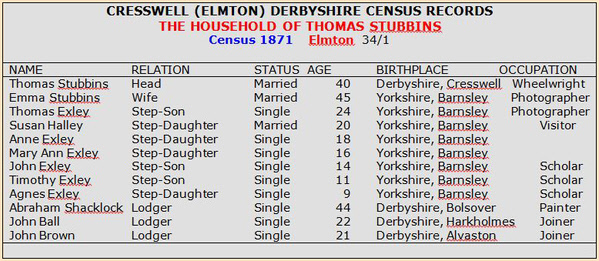
A second entry appears in the 1871 census for Thomas Exley who is identified as being at the premises of the new Photographic Studio in Worksop, Nottinghamshire.
In the ten years between 1871 and 1881 the situation changed for the Stubbins household. The 1881 census reveals that the family had moved from Elmton to Lound Common, in North Nottinghamshire. Lound, like Elmton, is a small, picturesque village and is situated between the market towns of Blyth and East Retford. With their move the family had also taken on the responsibility of a farm. In fact the 1881 census reveals that they were farming 42 acres. There remained with the family only two of Emma’s children, Mary Ann Exley Stubbins and Agnes Exley Stubbins.

So why did Thomas the wheelwright become a farmer? For some years after 1873/1874, the weather over the whole country was unusually bad. Many summers were wet and cold and, from Carlton-in-Lindrick in north Nottinghamshire, the school logbooks highlight the winters as being sometimes very severe. 1876 was a particularly bad year. The wheat harvest was ruined and often trading in wheat was suspended in Retford market owing to the poor samples on offer.
Everyone hoped that 1877 would be better but, in fact, it was worse. The summer was wet and the harvest was completely spoilt by continuous rain. Many villages flooded. Many large farmers at this time were desperately short of capital and to meet the shortfall many were reducing the amount of land they rented. So consequently Thomas Stubbings may have decided to take advantage of the situation as land was becoming more available. This may have been the trigger for him to move from his joiner’s shop in Elmton to a farm fifteen miles away in Lound.
In the first quarter of 1889, twenty years after her marriage to Thomas Stubbings, Emma died and her death was registered in Worksop. This spirited woman has left no memorial other than her name in census information and trade directories and a few of the photographs that she took.
Maybe she took the official portrait of her father-in-law Thomas Exley found in a book entitled ‘St George’s Church Registers’ in Barnsley Archive. There is no proof of who the actual photographer was but this is the earliest family portrait and Emma would have had her studio in Barnsley at the time that it was taken.
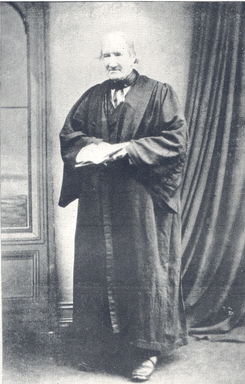
Thomas Exley Sexton & Clerk, St George’s Church, Barnsley 1822 to 1871
For further information on Thomas Exley, and an amazing discovery, see below.
Thomas Stubbins lived on for several years and in 1891 was in the home of Timothy Exley in Droylsden and by 1901, at the age of 70, was visiting William and Mary Woodhead in Creswell in Derbyshire. He may have died in the September quarter of 1907 with his death registered in Ashton under Lyme.
Family
Father John Willson
Mother Mary Willson nee Binns
Emma Exley (nee Willson)
Born 1824
Baptized
Married (1) 28 January 1841 to Timothy Exley (1823-1962) at Worsbrough, near Barnsley
Child 1 Jane Ann Exley, born 26 March 1843. Died 1846
Child 2 Mary Ann Exley, born 29 September 1844. Died 1854 Barnsley
Child 3 Thomas Exley, born 1846. Died 1921 Ashton under Lyne
Child 4 Emma Exley, born 9 May 1849. Died 1849
Child 5 Susan Exley, born 12 April 1850. Died Bramley 1887. Married (1) John Haley, Barnsley 1869 & (2) William Witts, Bramley, Leeds 1879.
Child 6 Anne Maria Exley, born 26 September 1852. Died 1873 in Worksop
Child 7 Mary Ann Exley (later Mary Ann Exley Stubbins), born 14 November 1854. Died? Married John Slater 1896 Ashton under Lyne
Child 8 John William Exley, born 1856. Died 26 June 1937 Manchester. Married (1) Eliza Bartholomew 1878 and (2) Sarah Wetherall 1894
Child 9 Timothy Willson Exley, born 1859. Married Annie Maria Graham Chorlton 1883. Died 1913 Stockport
Child 10 Agnes Exley (later Agnes Exley Stubbins), born 28 July 1861. Married William Bryan Taylor 1901 Prestwich. Died Manchester 1937.
Married (2) 14 March 1869 to Thomas Stubbings (aka Stubbins) at St. Mary’s Church, Barnsley.
Died 1889, aged about 65, at Worksop
~~~~~~~~~~~~~~~~~~~
Compiled by Ron Cosens © www.cartedevisite.co.uk
Sources
- Cathy Goldthorpe goldthorpe2@btinternet.com great great granddaughter of Mrs Emma Exley, family historian, who provided information for the life story above
- Barnsley MBC’s Archives and Local Studies Department for extracts from their records
- Sandy Barrie for trade directory information
- Ron Cosens for images from the Victorian Image Collection
~~~~~~~~~~~~~~~~~~~
Mrs Emma Exley – Gallery
See examples of Emma’s photography below. Also some images by Thomas Stubbins (aka Stubbings).
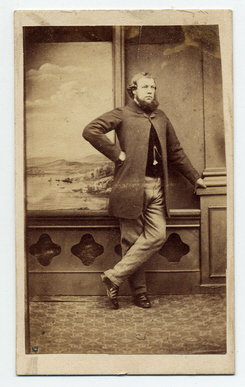 Mrs Emma Exley carte de visite photograph 1 |
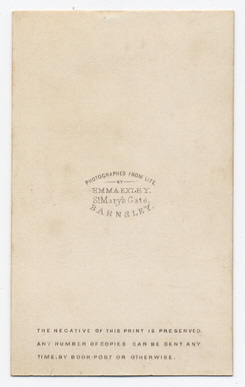 Mrs Emma Exley carte de visite photograph 1(verso) |
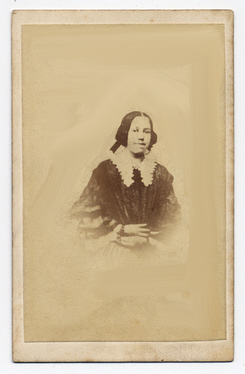 Mrs Emma Exley carte de visite photograph 2 |
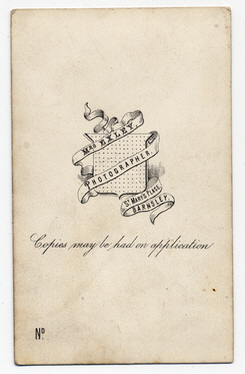 Mrs Emma Exley carte de visite photograph 2(verso) |
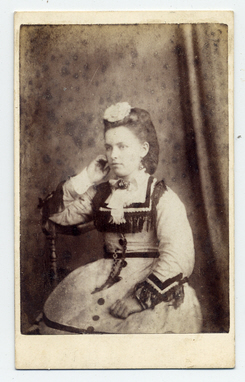 Mrs Emma Exley & Thomas Stubbins carte de visite photograph 1 |
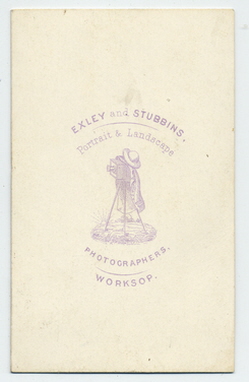 Mrs Emma Exley & Thomas Stubbins carte de visite photograph 1(verso) |
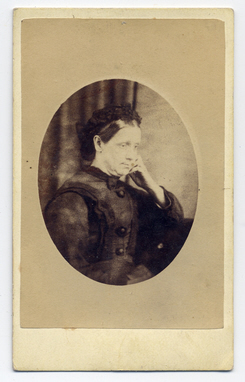 Mrs Emma Exley & Thomas Stubbins carte de visite photograph 2 |
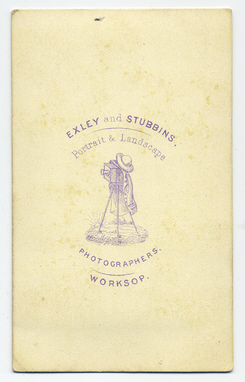 Mrs Emma Exley & Thomas Stubbins carte de visite photograph 2(verso) |
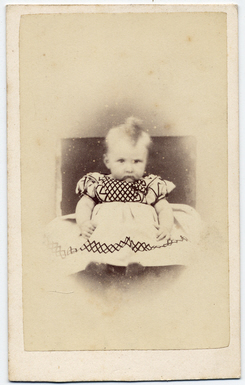 Thomas Stubbings carte de visite photograph 1 |
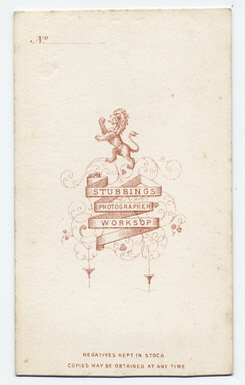 Thomas Stubbings carte de visite photograph 1(verso) |
~~~~~~~~~~~~~~~~~~~~~~~~~~~~~~
Thomas Exley – a missionary and some time photographer
Thomas Exley, the eldest son of Timothy Exley and Emma Exley, was born in 1846.
However, the hand of fate has revealed an interesting episode in Thomas’s early life.
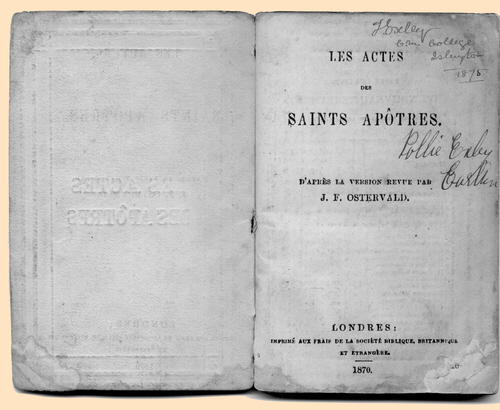
Marjorie Anderson, (grand-daughter of John William Exley and brother of Thomas) found a small book of ‘The Acts of the Apostles,’ written in French in a charity shop. She spotted in the fly leaf two signatures that she immediately recognized. In particular it was the reference to Carlton that signified to Marjorie that here was a family document. The first ‘T. Exley’, was followed by ‘C.M. College, Islington, 1875’ and yet further down the page in a different hand was written ‘Pollie Exley, Carlton’. She bought the book and because of this we have been able to track down more of Thomas’s life. Marjorie was unaware that Mary Elizabeth Allinson Exley, known to Marjorie as Auntie May was also known to other members of the family as Pollie. Clearly this book was passed down from Thomas to Pollie. So why did Thomas have a copy of ‘The Acts of the Apostles’ written in the French language?
The 1881 census reveals that Thomas Exley was visiting the George Bagshaw family at 29 Clarence Place, East Stonehouse, Devon. Thomas is identified as being an Evangelist (Missy). With regard to the ‘Acts of the Apostles’ this was the missing link that was needed. ‘Missy’ was presumably an abbreviation for missionary. What was Thomas’s connection with missionary work? Islington Local Studies Library confirmed that there was in Islington a Church Missionary Society College in the late nineteenth century. Clearly Thomas had attended this Institution in 1875 and he was learning French to help him with any overseas work with which he might become involved at a future date.
‘The Special Collection’ at Birmingham University Archives holds the records for the Church Missionary College in Islington. From these it is possible to ascertain that Thomas was admitted to the college on April 27th 1875. He is identified as being a photographer working at ‘The photographic Studios,’ Worksop. In 1874 his application was not immediately accepted and was sent to a sub-committee in Reading as there was some concern over his state of health.
He was accepted conditionally on probation. Committee Minutes including the register of students reveal that Thomas was still a student on 16th July 1875 and again on 26th November 1875 but by 1st March 1876 Thomas’s name no longer appeared on the list. He must have dropped out of the course during the first winter though no explanation is given in the records. It could have been that he was in poor health. Missionaries had to be robust to cope with the variety of demanding conditions they would find themselves.
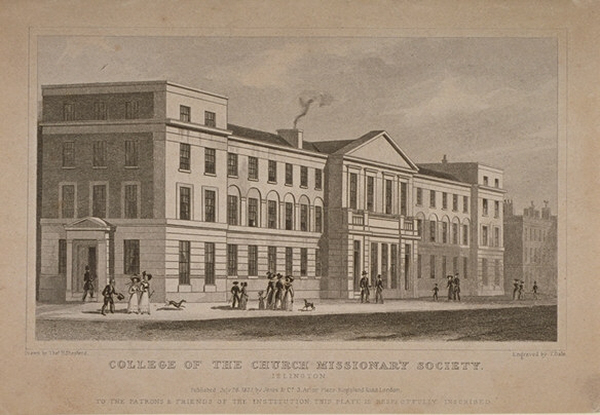
The account of Padre Rowland illustrates what life was like for a student at the College in the nineteenth century.
|
THE CHURCH MISSIONARY COLLEGE, ISLINGTON The Church Missionary College in Upper Street, Islington, was founded by the C.M.S. in 1825, at a time when Highbury Fields were real fields, and Islington a pleasant suburb. The College was intended for the preparation of missionaries, especially for those who had not the advantage of a university education. Men drawn from all ranks of life were represented in the community; men of varied vocations, and differing in the standard of education. Among the fifty-five students of 1860 were included university graduates, a solicitor, school teachers, a professor of music, a landscape painter, chemists, a soldier, and seven artisans. In addition to theological reading, Islington students were required to engage in evangelistic work outside the College. Amidst other work of this nature, the students carried on mission work in slums near the “Angel,” in Upper Street, inhabited mainly by a Roman Catholic Irish population, amongst whom no policeman could venture alone. These courts were regularly visited by the students, and day schools, Sunday schools, and services were held. Such work was naturally resented, and Dr. Stock tells a story of a six-foot student of those days who was confronted by a furious Irish virago waving a red-hot poker in his face! Taken from an account of Padre Rowlands 1860 |
The following account is taken from the Committee Minute report for April 27th 1875 and refers in particular to Thomas Exley.
|
Read Report of examination held by the Rev. J. E. Matthews (late Tutor at this Institution) in the week before Easter (at Reading). The Rev. R. Bren being in attendance expressed his views of the character and qualification of the Candidates under consideration. Resolved 1. That Messrs. T Exley, H.W. Eales, C.A. Gollmer, J. Grundy, J.W. Handford, T.A. Haslam, W. Roberts, I.J. Hagenheiber be admitted into the Institution as Probationary Students. Committee Minute Report 27th April 1875 |
There was no account in ‘The Minutes’ of why Thomas Exley left the College.
Although Thomas did not become an overseas missionary he seems to have spent the rest of his life travelling throughout England involved in preaching. Each census return states that Thomas Exley was single.
In the 1891 census he was visiting Charles Webb a grocer and draper in Longworth near Faringdon and is identified as a pastor. In the 1901 census a Thomas Exley, born in Barnsley, was visiting John Slater, his brother-in-law, a tea merchant manager at 33 Brook Street Ashton under Lyne and was working as a Preacher Plymouth. This no doubt refers to being a member of The Plymouth Brethren which is a conservative evangelistic Christian movement that gathered strength throughout the 19th century. In 1911 the census shows him again on the road visiting Arthur Tew a master tailor at 71 Midland Road Wellingborough in Northamptonshire and he is listed as an Evangelist.
In 1921 it would appear he died in Ashton under Lyne at the home of his sister Mary Ann Slater (nee Exley) close to his brother John and sister Agnes who were living in the Manchester area. Clearly his photographic career ended in Worksop in 1875.
To return to Emma’s biography, click here.
Timothy’s Uncle, Joseph Exley – the postman
Timothy Exley’s uncle, Joseph, had a mixed press.
|
THE BARNSLEY TIMES
26th January 1856
THE POSTMEN AND THEIR CHRISTMAS BOXES
TO THE EDITOR OF THE “BARNSLEY TIMES”
Sir, – I noticed in the Barnsley newspaper, a few weeks ago, a paragraph headed “The Case of Timothy Exley,” calling attention to the position of postmen and other officers connected with the post-office, and hinting at the desirability of presenting such public servants with Christmas boxes; instancing also the “dwindling down of late of those considerations to a mere shadow.” Now, Sir, I am not one who expects any man to do favours or perform services for me without a full and proper remuneration; but I claim a small space in your journal to relate a circumstance that has just come to my knowledge, and which is being fully discussed here respecting the Worsbro’ postman, who I am sure makes or might make, excellent wages so much so as not only to maintain himself and family, but also save money. I am informed that a few days ago he refused to convey a small parcel or parcels for one or more of his best friends, (who pay him well for all he does for them,) on the ground that the party sending the parcel had not given him a Christmas box. When gifts are demanded both from senders of messages or parcels as well as receivers, in addition to their being paid for, it need not be wondered at if Christmas boxes become extinct in such cases, and opportunities of adding to the wages of postmen become diminished. By giving publicity to this matter you will oblige many of your readers, and perhaps partly account for the future dwindling down of Christmas boxes in similar cases to the one I now call attention to. I am, Sir, your obedient servant, Worsbro’ Dale Jan.21 J.M. (We believe that the village postmen generally are very glad of conveying small parcels; indeed, these additions seem the chief means of helping out their incomes. The post-office wages being but a small consideration for the labours they have to perform. But the postman our correspondent alludes to may be, and probably is, an exception to the rule. We can ourselves give an instance where our apprentice handed three small parcels to the Worsbro’ postman a few days ago, which were severally addressed to Mrs. Newman, Darley-Hall: Mrs. Wilkinson and Mr. C. Wright of Worsbro’: and were all refused on the grounds our correspondent names. The united value of these parcels was sixpence, and the total weight 3 ounces, and would have passed through the post-office for one penny; and we are sure that the several parties to whom they were addressed either give a suitable payment for each parcel, or pay an annual consideration for the conveyance of such matters. We agree with our correspondent that it is not to be wondered at if Christmas boxes thereby dwindle to a shadow. Ed. Barnsley Times) |
The case did not rest here and yet another letter appeared a week later in The ‘Barnsley Times’ with a further comment from The Editor.
| THE BARNSLEY TIMES
2nd February 1856 TO THE EDITOR OF THE “BARNSLEY TIMES” Sir, – We, the undersigned, having seen with deep concern, a paragraph in the “Barnsley Times” of last Saturday, reflecting on the character of Joseph Exley, the Worsbro’ postman, and which, if uncontradicted, might be prejudicial to his interest, feel ourselves called upon to state – That the above-named Joseph Exley has been personally known to us for very many years, during all which time he has gained general respect among us for his strict integrity, uniform civility, and obliging manners and disposition. And we therefore express a hope that you will insert a copy of this statement in a prominent part of your next paper, as an act of justice to a long-tried and faithful servant. JOHN ANDREW, Incumbent of Worsbro’ A.M MAXTIN, H. FIELD W. NEWMAN, M.WILKINSON JOHN WOOD, J.B. GAZE, cashier W.B.WOOD The above is more united to our advertising columns, but as it came to hand anonymously, and too late to make application to any of those parties whose name appear at the foot of it, we, depending upon its genuinences, give insertion to it. We are glad to find that there are such redeeming qualities in the postman alluded to; but we can vouch for the correctness of the statement contained in our correspondent’s letter, which appeared in the Barnsley Times of last week. The incivility or stupidity which prompted the postman to refuse the parcels on the grounds which we described and which we stated were handed to him by our apprentice who had to be at his post at seven o’clock in the morning to give to him, seems irreconcilable with the above testimonial. Yet unless some suitable apology is given to qualify the dereliction of duty of which our correspondent complained, and of which we ourselves bore witness to, no testimonial of civility, faithfulness, however respectably signed, can alter the facts of the case related in the Barnsley Times of last week. ED. Barnsley Times |
This appears to be end of the matter. However according to Burland’s Annals of 22nd July 1857 Joseph Exley died the following year.
|
Burland’s Annals
22nd July 1857
Died, Joseph Exley, of Sheffield Road, Barnsley, after a severe illness, aged 46 years. During the last fifteen years, he had held the situation of letter-carrier between Barnsley and Worsborough; and had gained, by his industry and punctuality, the confidence of a wide circle of friends. |
To return to Emma’s biography, click here.
Barnsley’s Photographic Pioneers
The following notes add some interesting background detail to the development of photography in Barnsley. They are taken from an article written by Brian Elliott, B.Ed (Hons), M Phil.
|
In December 1842 it was reported in the Doncaster, Nottingham & Lincoln Gazette that a considerable number of most respectable parties’ had visited the Nobleman’s Stand at Doncaster Race Course for the creation of ‘Likenesses, as if removed from the surface of a mirror’. Edward Holland of Sheffield, the pioneering photographer responsible, also advertised his intention to visit several other Yorkshire towns including Barnsley. This was a remarkably early example of entrepreneurship since the invention of photography had been proclaimed only three years earlier. Antoine Claudet, an immigrant glass wholesaler from High Holborn, received personal tuition from Daguerre in Paris in the autumn of 1839, and bought a licence to practice in England. Claudet was a great enthusiast rather than an opportunist unlike the London speculator, Richard Beard, who obtained the exclusive English rights to the Daguerreotype. Beard opened his business in the roof of the Royal Polytechnic Institution on 23rd March 1841, the first professional portrait studio in England. Chadburns of Sheffield, manufacturers of scientific instruments and optics, purchased a licence from Beard in the summer of 1842 and by January 1843 were taking portrait photographs in purpose-built rooms at Brightside. With Sheffield in the hands of the Chadburn Brothers, Edward Holland’s licence was restricted to certain other Yorkshire towns. Holland left Doncaster in the middle of February 1843 and is known to have visited Bradford and Halifax but then appears to have surrendered his licence because of non-payment of dues. Although Holland and the Chadburns are unlikely to have visited Barnsley, they provide us with four salient features of the early trade:
THE 1850S: ‘TRUE TO LIFE THAT ONE WOULD ALMOST DEEMED THEY BREATH’ The 1840s were the very early years of photography when it was little more than a minority curiosity. In 1851, the year that marked the death of Daguerre, an innovation occurred which, because it was unpatented by its inventor, allowed the free expansion of photography. This was the Wet Plate Collodion process, devised by Frederick Scott Archer. It involved making negatives on sensitised glass plates and, like Daguerreotypes, the image quality was excellent. The main drawback was the need for exposure and development to take place in one operation – no problem in the comfort of a studio – but for outdoor work the intrepid Victorian photographer had to carry an entire dark room with him. The outstanding results achieved in hostile environments by pioneers such as Francis Frith (in the Middle East) and Roger Fenton (in the Crimea) involved a test of both determination and ingenuity. Locally as we can see in Harold Taylor’s article an unknown photographer was able to capture some of the pomp and ceremony of the opening of Locke Park on 10th June 1862. This view would probably been taken by a large wooden sliding box camera using a ‘whole-plate’ (6 × 8 inches 16.5 × 21.5 cm) and requiring an exposure time of at least five seconds, hence the blurred figures. Prints were usually made on albumen, paper manufacturers having to obtain huge amounts of egg whites to meet the demand. The patent-free wet collodion process lead to the phenomenal rise of the professional photographer. The census of 1851 and 1861 saw an increase from only 51 listed to over 2,500. In Sheffield the number of photographers in business in the ten years after 1854 increased from 4 to 30. By 1861 there were 25 professional photographers in Leeds and 9 in Bradford. Even the smaller industrial towns such as Barnsley could support three or four studios, at least one photographic shop and a lively trade in second-hand equipment. Photography had arrived … (Taken from an article written by Brian Elliott, B.Ed (Hons), M. Phil.) |
To return to Emma’s biography, click here.
